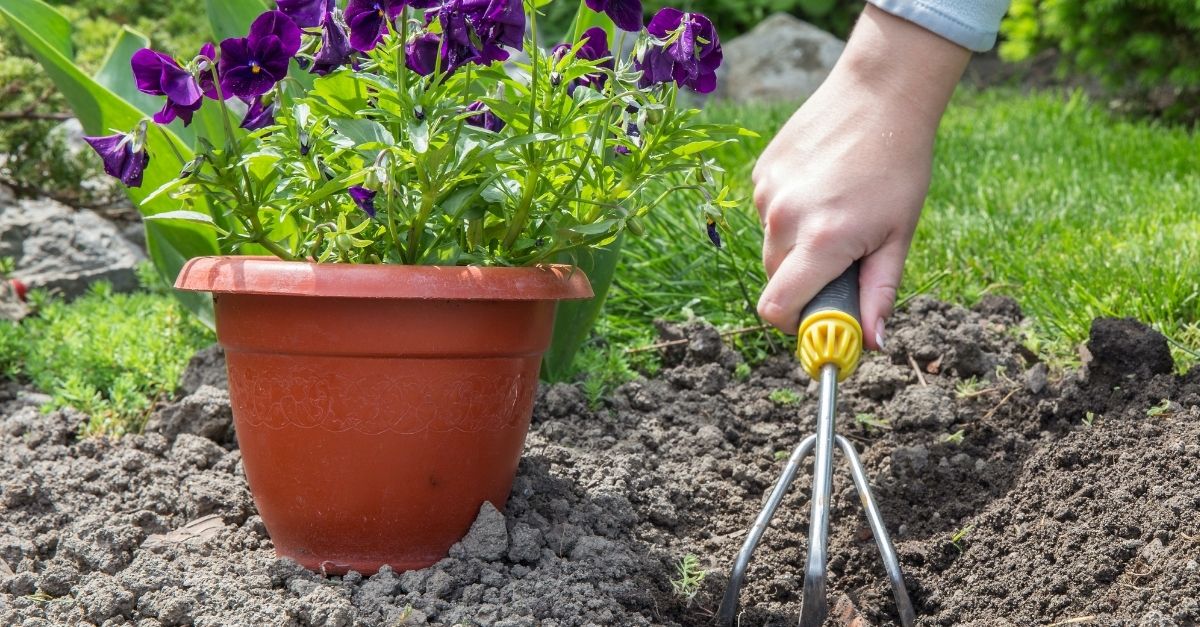We should take a look at the following quote before the Gardening Soil Preparation.
“Essentially, all life depends upon the soil… There can be no life without soil and no soil without life; they have evolved together.”
– Dr. Charles E Kellogg.
Soil is the soul and the ultimate base for gardening. It is the reservoir of all the essential elements for plants growth; nutrients, organic matter, air and water. It provides structural support for plants and acts as a medium for plants growth. What happens in the soil when it makes a difference to your plants’ health? Healthy soil is the secret behind a good harvest. It absorbs water, feeds our plants, provides an anchor for roots, and helps crops grow strong and productive. With proper care, you can improve soil every year, and plants will grow forever.
Gardening Soil Preparation | The Process
Select an area for gardening that receives a good amount of sunlight. Soil test to be taken to evaluate the nutrient, PH level and organic matter in it. As Geoff Lawton said, “It’s not the soil itself, it’s soil life that’s a most important element”. Soil test eventually gives an idea on how to prepare it. Once done, there starts the manual work. Remove the weeds manually or use tools. Uproot it thoroughly; weeds with seeds are to be discarded, weeds without seeds can be dried and used for mulching.
The soil should be loosened via tilling or ploughing, depending on the size of the land. For large areas ploughing can be done using pair of bulls or a tractor. For a smaller patch of land, hoe and handy tools can be used. Till the soil for about 8 to 10 inches and remove the big stones that come across. Tilling loosens the soil, inhibits weed growth, removes insects and improves aeration. Level the soil. Water and leave it for some time.
Enriching Soil with Organic Matter
Organic matter improves the quality of the soil. Organic matter is the natural, earthy material that, when decomposed, makes up the non-mineral part of the soil. Examples are rotted leaves, shredded barks, wood chips, grass, aged manure, compost, etc. The benefit is it helps the soil to retain more moisture while allowing it to drain. It improves the structured texture and adds all those essential microorganisms to thrive.
Plant matters like leaves, straws, and grass clippings are dumped into the soil months before planting to decompose. Adding nitrogen-rich organic manures like farmyard manure or cow dung manure increases macronutrients, humus content and moisture-holding capacity in the soil.
Composted manure can be added to the soil before planting. Avoid fresh manure as it can damage roots and introduce disease to the plants. Composting helps convert bulk organic material into soluble nutrients that trigger humus formation in the soil. Vermicomposting is another popular composting method. In this technique, earthworm converts the residues of food waste, green crops, manures into a form that plants can use.

Plant Cover Crops:
This technique controls soil erosion, suppresses weeds, builds fertile soil quality, eradicates diseases, pests, and enriches biodiversity. In this method, grasses like pearl millet, barley, rye, etc., and legumes like beans, peas are planted to cover the soil and not for harvesting purposes. Depending on the type, they add or uptake nitrogen. Note cover crops are used in the farm ground garden but raised bed.
Mulching:
It is a technique where the soil is covered with mulch. It creates the best environment for the soil to be at its best. Moisture level, humidity, temperature, carbon dioxide enrichment, and soil microbial activity miraculously increase and perform wonder. It gives a conducive environment; control weeds avoid leaching of fertilizer, makes the soil texture soft; once it decomposes, it acts as a fertilizer and increases production. Organic mulch includes dry leaves, dry grass, paddy husk, paddy straw, coconut leaves, and husks, anything decomposed, especially dry plant waste.
Garden Beds:
The plot can be broken into a narrow bed, set between access paths. The access path or walking space should be sufficient to move around. Garden beds can be flatbed, raised beds, rectangular beds or circular beds. Creating a bed that is suitable for the available place is always better. The bed system provides proper soil structure. The bed can be anywhere between 3 to 5 ft. It can be of any length, with a cross path to access it from all four sides. The size of the bed can be determined according to the space available quantity of plants that are being planned.
Flatbed:
It’s a simple bed, made easy. This bed is suitable for dry areas as less area is exposed to wind and sun, the moisture will not quickly drain away.
Raised Bed:
This bed type is built (raised) higher than the surrounding path. It results in higher yield and no dig cultivation. Dig out 6- to 8-inch soil and drop this on the bed, creating a raised structure. The bed should be 8 to 10 inches deep and 3 to 4 feet wide.
Urban gardeners create raised beds with a wooden or brick frame to make them permanent.
Bad Worms in the Soil
The worms in the soil are of two categories viz. beneficial ones like earthworms and harmful like cutworms larvae, white curb worms, root-knot nematode. These three worms are the most common hazardous worms in the soil.
Cutworms belong to the moth family. Both adult and larvae cutworms rest beneath the soil day time and feed on plants during the night. They destroy plants by eating near the stem and leaves. It can be prevented by removing weeds and plant debris that feeds and shelters the larvae. Turn the soil after every season, clean up and allow predators like birds to feed on it. Plant sunflower castor oil plants along the edges; it attracts cutworms and is easy to locate and eradicate. Keeping birdbath and inviting birds can help to destroy its population.
White curb worms or rootworms are soil inhabitants; they feed on organic matter affecting the root system. They are polyphagous pests. Use of neem oil diluted with water can help control it. Birds also feed on these worms. Making the garden bird-friendly will help us in many ways.
Root-knot nematode is a parasitic microscopic worm invading the soil and roots of the plant. Crop rotation and solarising the soil is the best solution for eliminating these worms.
Indoor Gardening Soil Preparation/Mix
Potting mix for indoor plants needs to be fluffy and light. It should have decent drainage and moisture-retaining capacity. Compact soil will not retain moisture or hold an excess of water, leading to over-saturation. A proper potting mix serves as a foundation for gardening.

There are basically three ingredients that go into the potting mix.
1. Coir/Cocopeat:
Coco peat is dried and compressed coconut fibre with good water-retaining capacity. It retains water and releases it gradually to roots. It is easy to handle and reduces the weight of the potting mix. Usually, coco peat comes in the form of a brick. Soak the brick in the water for about 10 minutes (3-litre water for 600gram block). It will absorb water and expand into a powder form that’s ready to use.
2. Vermi compost/Composted Manure/Compost:
These three are traditionally used high fertility manures that feeds plants and conditions soil. Bone meal fish meal can also be used as fertilizer but only a handful.
3. Soil and Perlite:
Garden soil is enriched with organic matter and microorganisms, so it’s nutritious for plants. Perlite is a natural mineral that helps regular pot soil, and it’s optional.
Check whether the pot to be used has proper drain holes. Add gravels at the bottom as it allows the water to seep down and does not let the soil erode away.
Mix coco peat, fertilizer and soil in the ratio of 2:2:1. A spoon of neem cake can be added for pest control. Once added, the pot is ready for planting. For indoor plants, it’s essential to keep a plate underneath to collect excess water so that the place can be kept clean.
For indoor plants, it’s essential to find a place where there will be sufficient sunlight, temperature and humidity.
Terrace gardening:
For terrace gardening, the same potting mix can be used with a small change, 1/3 of the pot being filled with coco peat or sugarcane waste, and the remaining 2/3 should be filled with a pot mix of coco peat, fertilizer and soil in the ratio of 2:2:1. Leave 2 inches of the upper part of the pot free, add a layer of dry leaves for mulching. Biofertilisers like pseudomonas can be used.
Garden Soil Vs Potting Soil
Garden soil is a naturally available resource that’s blessed with organic matter and compost. The texture is heavier and retains water for a longer time. It provides the plant with vital nutrients microorganisms. It’s easily available and affordable.
Potting mix is a man-made, formulated one. It is used in a container for gardens, both in and out. Potting soil is a mixture of coco peat, fertilizers in manure, compost or vermicompost and soil in the ratio of 2:2:1. Mixed in a proper ration, it acts as a healthy growing medium for plants. Potting soil can be made using perlite and vermiculite instead of soil. It can be expensive at times. Potting mixes are blends specific for plants like cactus, succulents, orchids, roses. It can be done in many ways according to materials available and plants requirement.
Sand for Gardening Soil Preparation
The unique capacity of sand is creating air pockets, increasing drainage and aeration. It has the coarsest particle. Adding sand to the garden soil can either be a boon or a bane simultaneously. If the soil is heavy in texture adding sand is recommended. It will enrich the soil texture and benefit the plants. The quantity of sand added is very significant for successful plant growth. If mixed in proper proportion, it will enrich aeration and give more room for the roots to spread out. Compact soil can be loosened and made ready for the plants. Especially underground vegetables like tubers need loosened soil. If more sand is added to the soil, it will decrease fertility. A balanced mixture of sand with clay soil in the ratio of 50:50 can make it lighter. For other types of soil, you can add 25 percentage of sand. So, sand is very essential for gardening soil preparation. Click here to know more information about how to make garden soil.
Gardening Soil Preparation | The Final Verdict
Half of the soil consists of solid particles, and the rest is a combination of air and water. These three are essential for plants life. As Mahatma Gandhi once said, “To forget how to dig the earth and tend to soil is to forget ourselves”. Soil is the ultimate crust for all living being on the planet. Keeping it fertile and tending to it is the key to life on our planet. Sustainable living can be promising when the organic content of the soil is retained. Maintaining soil health would, in turn, improve our health for generations to come. You can check our store for other products.

Leave a Reply